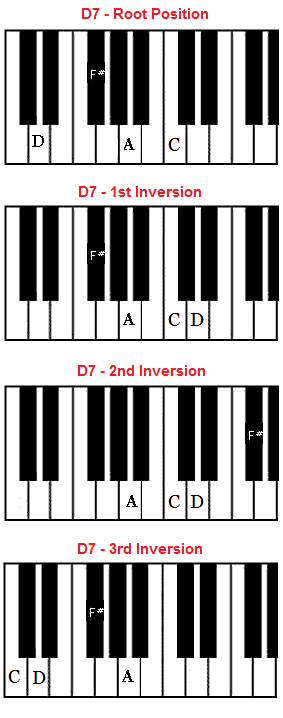Let’s learn how to play a D7 chord on piano. This chord is formed by combining the root, major third, perfect fifth and flat seventh of the D major scale. The notes of the D major scale are D E F# G A B C#. To play a D seventh chord we play the 1st, 3rd, 5th and flat 7th of the scale or D-F#-A-C. Please note that you do not play the 7th note of the scale. You play a pitch a semitone lower, which is the note, C.
The right hand fingering for this chord is as follows. D is played with the first finger or G, F sharp is played with the second finger, A is played with the 3rd finger, and C is played with the 5th finger.
Highly Recommended: Click here for the BEST piano/keyboard course I’ve come across online.
There are different names for the the D seventh chord, namely D7, D dominant 7 and D dom7. To play a D7 chord, you play the D triad consisting of the notes D F# and A, and you add the note forming an interval of a 7th above the root note, D.
If you play a D dom7 chord on your piano or any other instrument for that matter will hear that it wants to move to another chord and no other. It wants to move to the chord, G which is a perfect 4th above the D dominant seventh chord. You don’t have to move to G, but this is the chord a D 7 chord would naturally move to.
Let’s talk for a while about the different intervals in D7. This chord is made up of a major third plus two minor thirds. The notes move from D to F# which is a major third consisting of two tones. F# to A is a minor interval, consisting one and a half tones. A to C is another minor interval and consists of one and a half tones.
Learn how to play piano chords with the Piano For All piano course.
Take a look at the chord diagram below. On this diagram the D7 chord is in root position and its first, second and third inversions.
In root position the notes of the D seventh chord are D-F#-A-C, as we have seen before. What if we were to move the note D an octave higher? This would now give us the note sequence F#-A-C-D. This is the first inversion of the chord. Let’s now move the note, F# one octave higher to give us the second inversion of the chord. The notes for the second inversion of D7 is now in the sequence, A-C-D-F#. Lastly, we learn how to play the D dominant seven chord in its third inversion. If we raise the note, A one octave higher, the pitches would now be in the sequence C-D-F#-A. This is the third inversion or voicing of the chord. You can clearly see that no matter what the inversion, the notes are the same. The only thing that changes is where they are in the sequence of notes.
For learning how to play piano, I highly recommend Piano For All and Rocket Piano. I talk about these piano lessons here. There are many free lessons on piano-keyboard-guide.com but these courses can help you speed up the learning process. The good thing about these piano lessons is that they help you avoid traditional boring methods of learning to play piano and keyboards.
Do you want to learn how to play other chords. Check out our main piano chords page. Return from D7 Chord to main Piano Chords page. You can learn to form all kinds of chords including major, minor, seventh, diminished, augmented, and even more advanced ninth, eleventh and thirteenth piano chords.
Free Piano Lessons: The Home Page